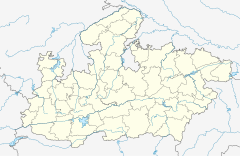This article needs additional citations for verification. (March 2012) |
The Varaha Temple at Khajuraho (Devanagri: वराह मंदिर) enshrines a colossal monolithic image of Varaha, the boar avatar of the Hindu god Vishnu. This temple depicts Varaha as a purely animal form. The temple is located in the Western Group of Temple Complex Khajuraho Group of Monuments, a World Heritage Site inscribed by UNESCO in 1986 because of its outstanding architecture and testimony to the Chandela dynasty.[1][2] Khajuraho is a small village in Chattarpur District of Madhya Pradesh, India.[1]
| Varaha Temple | |
|---|---|
वराह मंदिर | |
 Varaha temple at Khajuraho | |
| Religion | |
| Affiliation | Hinduism |
| District | Chattarpur, Khajuraho[1] |
| Deity | Varaha, Incarnation of Vishnu |
| Location | |
| Location | Khajuraho[1] |
| State | Madhya Pradesh |
| Country | India |
| Geographic coordinates | 24°51′7.3″N 79°55′20″E / 24.852028°N 79.92222°E |
| Architecture | |
| Creator | Chandela Rulers |
| Completed | CIRCA 900–925 AD[1] |
| Temple(s) | 1 |
Legend
editVishnu appeared in the form of a boar in order to defeat Hiranyaksha, a demon who had taken the Earth (represented as the goddess Bhudevi) and carried her to the bottom of the cosmic ocean. After batting for a thousand years, Varaha slew the demon. He carried the Earth out of the ocean between his tusks and restored her to her place in the universe. Vishnu married Bhudevi in this avatar.
Description
editThe Varaha Temple is one of the monuments among Khajuraho Group of Monuments, a World Heritage Site in India. It is dated to c. 900–925 AD.[1] Inside the temple complex, Varaha Temple is located next (South) to Lakshmi Temple and opposite to Lakshman Temple.
Architecture
editThe Varaha Shrine, built on a lofty plinth,[1] is simple and modest. It has an oblong pavilion with a pyramidal roof of receding tiers, resting on fourteen plain pillars.[1] The shrine is built entirely of sandstone.[1]
The statue of Varaha is 2.6 m long[1] and 1.7 high.[1] The sculpture is colossal and monolithic and made of sandstone. The sculpture is carved with numerous figures on its entire body (also seen in image). The sculpture carved between nose and mouth, depicts goddess Saraswati carrying Veena in her arms.[3]
Gallery
edit-
Varaha Temple, Khajuraho India.
-
Varaha Temple, Khajuraho India.
-
Varaha Temple, Khajuraho India.
-
Varaha Temple, Khajuraho India.
-
Varaha Temple, Khajuraho India.
-
Varaha Temple, Khajuraho India.
-
Varaha Temple, Khajuraho India.
References
edit- ^ a b c d e f g h i j k "Archaeological Survey of India (ASI) - Varaha Temple". Archaeological Survey of India (ASI). Retrieved 21 March 2012.
- ^ "Khajuraho Group of Monuments". UNESCO World Heritage Centre. United Nations Educational Scientific and Cultural Organization. Retrieved 25 June 2023.
- ^ Ramakrishna, Lalitha (September 2018). "Grand temples of Madhya Pradesh". Tattvaloka. XLI (6). Sringeri: Sri Abhinava Vidyatheertha Mahaswamigal Educational Trust: 47–52. ISSN 0970-8901.
External links
edit- M.P. Tourism Website, Official Website of Madhya Pradesh State Tourism Corporation, Khajuraho
- Archaeological Survey of India, Bhopal Division, Index Page for Khajuraho - Chhatarpur
- Archaeological Survey of India, Bhopal Division, Varaha Temple, Khajuraho
